Mary’s Infamous Mural: Iconic Art for an Iconic Bar
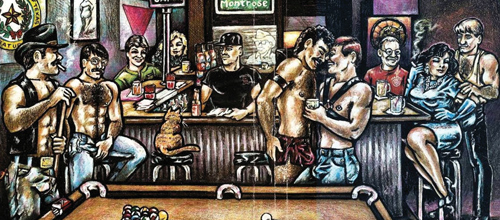
Inimitable gay artist Scott Swoveland painted more than 500 different scenes on the front window of Mary’s bar from 1990 to 1999, but his signature piece was the famous—or infamous—mural that he painted in 1997 on the bar’s outside east wall. Swoveland speaks with OutSmart’s Brandon Wolf about his years at Mary’s and about the genesis and meaning of his iconic mural.
Mary’s bar, at the intersection of Westheimer and Waugh Drive, seemed like one of those things that would last forever. Indeed, it was in the same location for nearly 40 years, anchoring Houston’s gay community in the Montrose area.
But times changed, and Mary’s began to find itself more and more alone. While gays were moving to the suburbs, the Internet was killing off the gay specialty stores. Still, Mary’s stood there—a survivor from the old days. For many gay men, Mary’s was symbolic of their own survival. They had dealt with bar raids, hate crimes, city referenda, and AIDS during the Mary’s years—and like Mary’s, they were survivors, too.
Along with the outside color of the bar, Mary’s changed ownership several times in four decades. But one thing remained constant: every week, the front window bore a freshly painted design advertising an upcoming event, paying homage to someone special, or just displaying a pure flight of whimsy.
In case someone still didn’t get it, a provocative mural was painted on the bar’s east outside wall in 1997 for that year’s Pride month. Its meaning was unapologetically “This is our turf!”
In the mural, two shirtless leather men with hirsute chests and bulging crotches stood just inches from each other, peering into each other’s eyes with unbridled love and lust. Looking on, or playing pool, was a decadent cast of other bar regulars. Sitting attentively on a stool in the center was the bar’s mascot cat, Mr. Balls.
500 Windows
Scott Swoveland worked at Mary’s from 1990 to 1999. He was first hired as a part-time barback, but as his artistic talents became more and more obvious, Mary’s owners asked him to work full time. He painted the weekly windows, designed the ads for This Week in Texas and the Houston Voice, took on numerous creative projects, and barbacked when available.
Swoveland’s window designs advertised military parties, crawfish boils, and other social events held at Mary’s. He usually coordinated window themes with the bar’s ads.
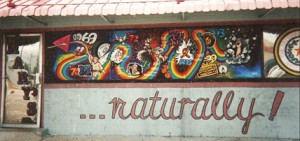
Sometimes the window would be a special tribute, such as the AIDS Quilt display on the National Mall in Washington, DC. If there was a week with no special event or tribute, Swoveland was free to play around with his own fantasies. One of his favorites was an “Alice in Wonderland” window, with Mary’s regulars painted in as the characters.
Swoveland figures that he painted at least 500 different windows during his years at Mary’s. “I’d meet with Gaye and Cliff on Monday morning, and they would tell me what they wanted—usually advertising a party or fundraiser coming up that week. I would do a sketch for their approval and then begin the window.”
The front window consisted of four panels. The panel on the far right was permanently painted with Mary’s “National Bar of Texas” logo. The other panels were used for the ever-changing weekly designs.
“The windows are made of Plexiglas,” Swoveland explains. “Because the bar was a target for homophobes, it didn’t make sense to use glass that could shatter. I was often the target of slurs yelled from passing vehicles, and at least three times beer bottles were thrown at me, smashing against the front wall.”
Swoveland used tempura, a chalk-based paint, to draw his designs. “The paint comes off easily with a hose,” he says. Each new window took a day to paint. Swoveland would start at 10 a.m. and finish just before the sun went down. One window—a gay pride timeline—took him two days to finish.
“Once in a while, I used a grease pencil to make outlines, but most of the time I just painted the design from memory,” he says. “If there was a particular pose or detail I needed to see more closely, I had a 5×7 sketch-book that I could refer to.”
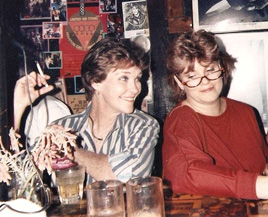
Pushing the Limits—“HPD says you have one hour . . .”
“My windows were painted during the height and aftermath of the AIDS epidemic,” says Swoveland. “Mary’s had become the epicenter of the epidemic. If people weren’t planning or hosting a fundraiser there, they were holding a memorial service.”
Swoveland felt that the gay community, especially those living with AIDS, had largely been shunned by the rest of society. “So we had to take care of our own,” he says.
The most visible fundraising personality at the time was Marvin Davis, otherwise known as Lady Victoria Lust. Swoveland says he developed great admiration for Davis and volunteered to do any PR work that he needed.
Davis died in 1996. “Don Gill, Regina Dane, Rita Charles, and many, many others rallied the community, and with the help and support of the bars, got things done,” says Swoveland.
“My small part in this,” he says, “was the windows. I wanted to draw positive, upbeat images showcasing the fun side of being gay and proud. Especially considering that many, many friends, neighbors, lovers, and members of the community were dying all around us, I wanted to draw over the top, so there were lots of hot, nearly naked males and females in the designs.”
Pushing the limits was something Swoveland had fun doing. Every now and then, however, Mary’s former co-owner Yancey would call him into her office. “With a half-smile she would tell me that the Houston Police Department had called and that I had one hour to revise the design,” he remembers.
One design for Let Us Entertain You (LUEY) Weekend included two characters in a position that closely resembled oral sex. Swoveland ended up drawing a floating party balloon over the objectionable area.
“But the strangest censoring was a Halloween design,” Swoveland recalls. “On one side, I had a female in Daisy Duke shorts kissing a female genie. On the other side, I had a hot-looking male vampire and a scantily clad young male at his feet. Drops of blood dripped from the vampire’s teeth. HPD said we were promoting unsafe sex.”

The Mural
“What a lot of folks do not realize is that the now-infamous mural at Mary’s was actually the second mural that I painted for the bar,” Swoveland explains. “A few months before his death in 1991, Fanny [bar owner, Jim “Fanny” Farmer] asked me to update the previous mural on the side of the bar.
“The mural at that time was just a black-and-white rendering of Janis Joplin screaming into a concert microphone, the Houston Motorcycle Club [HMC] logo, and the silhouette of a leather man. I don’t know who the artist of that mural was, and Fanny never said. But the mural was rumored to have been there since the ’70s.
“Fanny requested that I paint an updated picture of his favorite singer and friend, Janis Joplin, and a portrait of his pet German Shepherd, Sam, who had died sometime before. Fanny also wanted a leather man of some sort on the wall and, of course, the HMC logo. A group of us bar regulars decided to add a portrait of Fanny as well. The leather man and cowboy were figments of my imagination. I changed Janis’s pose to a promo-picture stance, so that she could stand beside Fanny.”
The third mural at Mary’s (Swoveland’s second) was painted for the Gay Pride Parade in 1997, according to the date that Swoveland signed on the concept sketch. “I originally thought the mural was done earlier, but time goes by and so does my memory,” he says, laughing.
In 1997, the bar was owned by Gaye Yancey and Cliff Owens, and they were uncertain as to whether Mary’s could continue as a viable business. In an effort to breathe new life into Mary’s, Yancey and Owens decided to give Mary’s a “facelift” in time for that year’s Pride parade.
“It was decided that the new mural would pay homage to the past, as well as depict the way the bar was then,” Swoveland says. “I was pretty much given carte blanche as to what to paint.”

The Mural’s Inspiration
“I was fascinated with a campy gay greeting card of the times,” Swoveland reveals. “It featured a wide-eyed Dorothy and Toto from the Wizard of Oz in the midst of a leather bar.
“I played with the idea in my mind for about a week or so. A lot of the insane thoughts that went through my head usually ended up on the front window. So just to test the waters, I painted a window design while I was playing with the concept for the mural.”
“The window was slightly different than the final mural design,” Swoveland says, “and the window version was directly influenced by the greeting card. Of course, being a Mary’s window, I had to include other elements from pop culture at the time, including Beavis and Butthead, and the Grinch. In the background of the picture is Wilma Flintstone holding a sign which read ‘Will Work for Sex,’ which was my way of poking fun at bartender Will ‘Wilma’ Johnson, who was one of my closest and dearest friends.”
The window was well received, and Swoveland presented his ideas for the mural concept to Yancey and Owens for the final green light. “I decided to do my own version of the inside of Mary’s on any given night,” he says.
“I wanted the mural to look as if the front window of the bar had been removed, and one could look inside,” Swoveland explains. “Everything which is depicted in the mural of the bar interior is exactly as it was at the time—the tin-plated bar front, the beige pool-table top, the ‘Gay Street’ sign, the dartboard, and lots of other little details. I included portraits that the patrons would recognize.”
The bar owners and regulars loved the idea, and the project was given the go-ahead. It took Swoveland a week to complete the mural—just in time for the 1997 Pride parade.
Swoveland notes that the mural was very upbeat. The people in the picture were smiling and happy. It was his way of counteracting the enormously grim emotional toll of the AIDS epidemic. It showed that despite great tragedy, the gay community was still determined to focus on life and living, with great passion.
The purposeful decadence of the mural was a giant middle finger to the people that Swoveland felt had turned their backs on gay men with AIDS. Swoveland was a member of Queer Nation at the time. The mural, like the organization, said unapologetically “We’re here! We’re queer! Get used to it!”
“Everyone I knew at the time was at Mary’s,” Swoveland says. “Our lives revolved around it during those days. For me, ‘home’ was Mary’s.”
The End of an Era
Jim “Fanny” Farmer bought the two-year-old bar in 1970; attorney Cliff Owens became a co-owner in the late ’70s. When Farmer died in June 1991, his share of the bar passed to Gaye Yancey and Terry Smith. The three continued to operate Mary’s into the early 2000s. In 2006 the playful mural was painted over with blue sky and puffy white clouds; some speculate that it was because, with its gentrification, Montrose was no longer a suitable habitat for the tongue-in-cheek ribaldry that was Mary’s east-wall mural.
In November 2009, Mary’s closed its doors forever. The community could only watch and speculate as the building and its large backyard patio and park fell into disrepair, suffering repeated acts of vandalism. The speculation ended earlier this year as plans were announced for the Blacksmith coffee shop to open in the renovated bar in the spring of 2012. Mary’s back lot has been leveled and prepped for construction of a parking lot for The Hay Merchant craft beer bar and chef Chris Shepherd’s Underbelly restaurant across the street.
Gone is the patio area where beer busts for hundreds had taken place, where anonymous sex in secluded corners was so common that patrons didn’t even glance, and where hundreds of memorial services for AIDS victims had been held.
Gone, too, are the numerous shrubs planted in the back lot in honor of AIDS victims. Fortunately, the Gulf Coast Archive & Museum (GCAM) salvaged the unique bar tops and other select relics from the original building and patio.
There was no way left to ignore the truth. The formerly casual, unfettered, Bohemian attitude of “the Montrose that was” had come to an end. The past was now the stuff of memories and legends.
A Surprising Salvation
Last June, local artist Cody Ledvina announced that he and local art collective The Joanna would be restoring the mural. A call was put out, and nearly 20 volunteers showed up to help with the task of recreating the mural.
In an interview with Free Press Houston, Ledvina stated, “This mural is a public art masterpiece. It’s a period piece and it’s a little bit ridiculous, but it’s by no means vulgar.”
The restoration began by projecting an image of the original mural onto the wall and outlining the major components. The lone surviving image of Mr. Balls was cleverly used to set the correct placement and scale.
Volunteers helped to paint in all the details of the mural, and on the Thursday evening before the Pride parade, the mural was completed. Ledvina even included a nod to Houston street artist Coolidge. Beneath the mural’s bottom edge is a stenciled Tyrannosaurus rex, left earlier by the artist. Ledvina’s crew left the small dinosaur image, but painted a leather daddy hat on it.
Within 12 hours following the completion, an unknown vandal defaced the
mural with a paintbrush and silver pigment. Xs were painted on the male crotches, and a checkmark was placed on the woman in blue.
That Friday morning, Ledvina sanded down the unwanted additions and restored the integrity of the mural, laughing at the renegade attempt to make a statement. Knowing that the woman in blue was a drag queen, Ledvina quipped: “I guess the ‘artist’ was saying gay men are not okay, but a woman with a penis is.”
Since completion of the mural, owners of the property have announced that the restored mural will not be permanent. They plan to use the wall for a rotating public art series.
In his Free Press Houston interview, Ledvina said his group has already made plans to recreate the mural on an inside wall of another bar. He hasn’t yet disclosed the name of the bar, but said, “It’s a bar that a lot of folks go to.”
__________________________
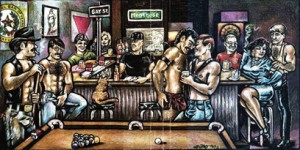 In His Own Words:
In His Own Words:
Mural creator Scott Swoveland reveals the entire cast of Mary’s Mural
Sitting by the Gay Street sign on her usual perch is bar co-owner Gaye Yancey. Behind the bar is beloved bartender and my dear friend, Will “Wilma” Johnson.
In front of the dartboard, nursing a Scotch, is co-owner Cliff Owens. The drag queen in the blue dress, smoking a cigarette, was my best friend at the time, entertainer extraordinaire Frank “Rita Charles” Riojas.
The man standing behind Rita was a friend of mine named Jeff Heine. Unfortunately, Jeff’s portrait, except for the blond hair, doesn’t look much like him. After I painted the portrait, he got paranoid about his face being on the side of an infamous gay bar and asked me to change it up a bit. But then such were the times of the ’90s. Folks in some cases had to be afraid.
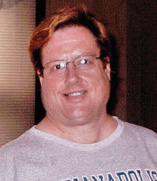
The three bar patrons in the front are combined portraits of the Wolf Pack members. I took features from several of them and combined them into three people, saving me from having to play favorites.
The cat is Mr. Balls, a stray cat with extremely large testicles who adopted the bar as his home and had his very own bar seat. The guy with the cowboy hat holding the pool stick is nobody in particular, just my homage to the original source material of the greeting card.
The blond peeking out of the back of the bar is my funny way of sneaking myself into the painting. It is yours truly in drag as Ruby Barbeaux. On a dare that year, I entered the Mother of Montrose contest, and to my surprise, I won!
Long-time patron and bar fixture Cassandra McCory is dressed as Betty Grable. The portrait that hung on the wall was faithfully and lovingly represented so that Cass was indeed recognizable in the photo.
Finally, the see-through ghost behind Wilma is Jim “Fanny” Farmer in his usual seat. When he got sick, Gaye sat on one side and Cliff sat on the other, to make sure he didn’t fall off. We all felt that Fanny never left the bar—literally—since his urn and ashes were planted in the Outback.
Brandon Wolf is a frequent contributor to OutSmart magazine.











Comments